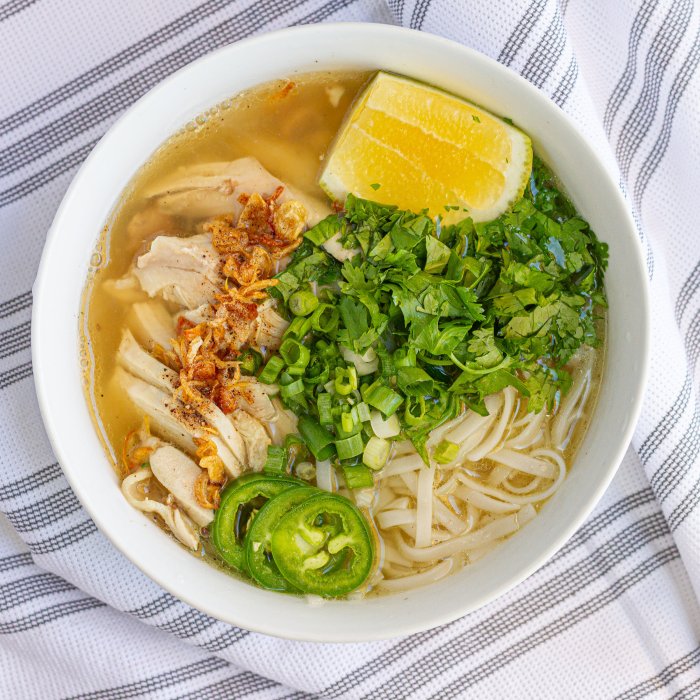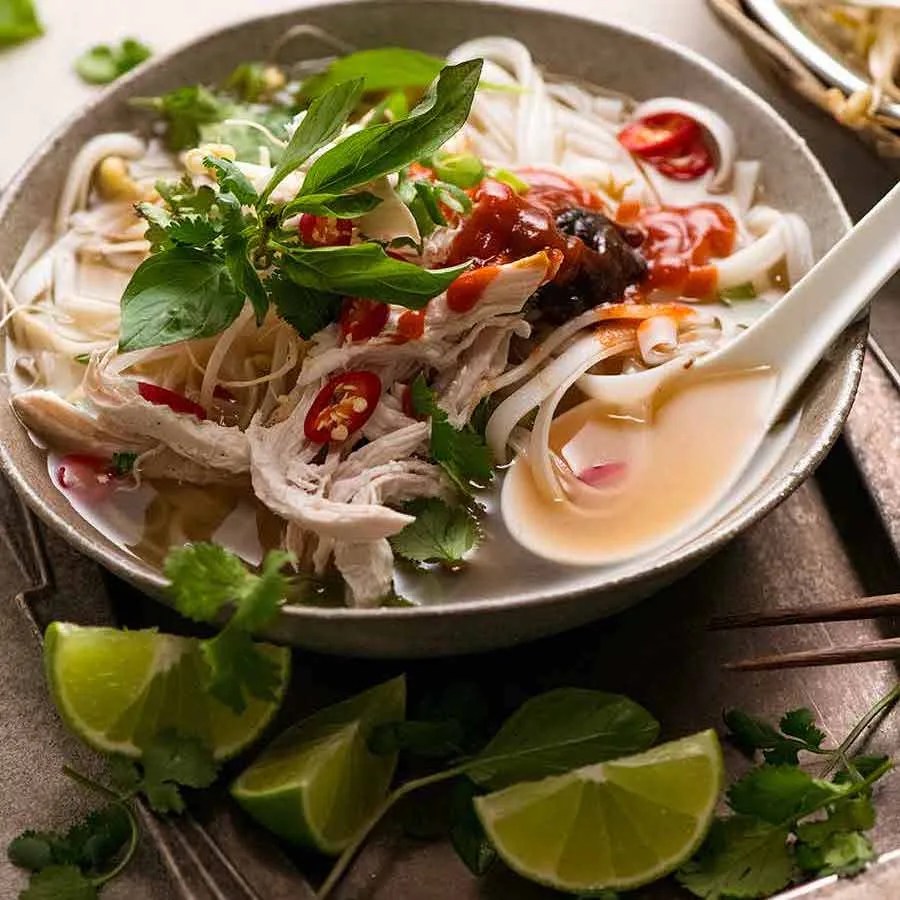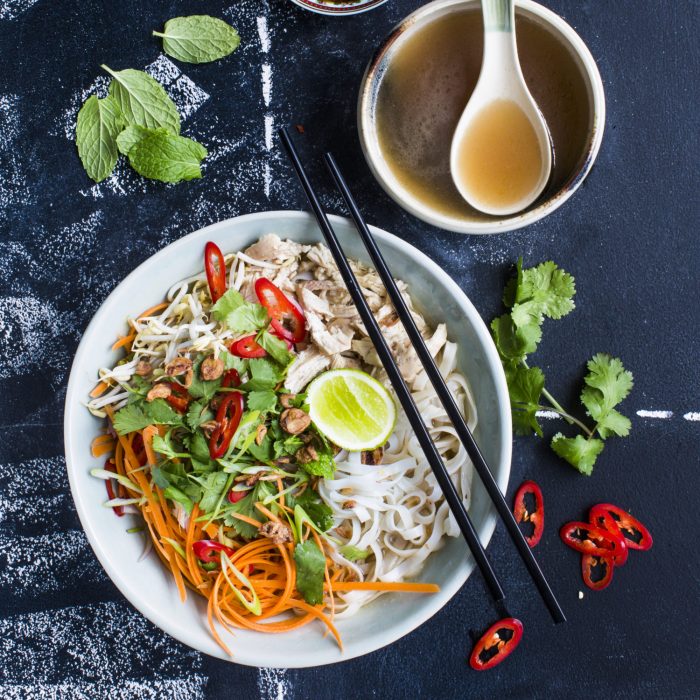Pho Chicken Soup Recipe Variations and Techniques
Pho chicken soup recipe – This section delves into the diverse world of pho chicken soup, exploring regional variations, broth preparation methods, ingredient selection, serving styles, and troubleshooting common issues. We aim to provide a comprehensive guide, empowering you to create delicious and authentic pho at home, regardless of dietary needs or experience level.
Regional Pho Chicken Soup Variations

Source: squarespace-cdn.com
Vietnamese pho boasts regional distinctions, each showcasing unique flavors and ingredients. The following table highlights three variations: Northern, Central, and Southern styles.
| Region | Key Ingredients | Cooking Method | Serving Suggestions |
|---|---|---|---|
| Northern Vietnam | Clear broth, often featuring ginger and star anise; lean chicken; thin rice noodles; fresh herbs (cilantro, basil, mint); lime wedges | Slow simmering for a minimum of 6 hours, prioritizing a clean and delicate flavor profile. | Served with a side of chili garlic sauce for added heat. |
| Central Vietnam | Rich and savory broth, frequently incorporating fish sauce and shrimp paste; chicken thighs for richer flavor; thicker rice noodles; pickled vegetables (carrots, daikon radish); bean sprouts | Pressure cooking to reduce cooking time while maintaining a flavorful broth. | Garnished with crushed peanuts and fresh herbs for added texture and aroma. |
| Southern Vietnam | Sweeter broth, often using palm sugar and lemongrass; chicken breast; wide rice noodles; fresh herbs (cilantro, basil, mint); bean sprouts; lime wedges; sliced red chilies | Combination of slow simmering and quick stir-frying of aromatics before adding broth ingredients. | Served with a variety of dipping sauces, such as hoisin and sriracha. |
Dietary-Restricted Pho Chicken Soup
Adapting the recipe for dietary restrictions is achievable with thoughtful substitutions. A gluten-free, low-sodium pho can be created by using gluten-free rice noodles and reducing or eliminating added salt. Chicken broth can be made from scratch, carefully controlling sodium levels. For flavor enhancement, consider using more fresh herbs and spices, such as ginger and garlic.
Adjusting Spice Levels in Pho
The spice level of your pho can be easily customized. Below is a guide for adjusting the spice intensity to your preference.
- Mild: Use a small amount of chili flakes or a mild chili paste.
- Medium: Incorporate a moderate amount of chili flakes or a medium-strength chili paste. Add a few slices of fresh chili.
- Spicy: Use a generous amount of chili flakes, a spicy chili paste, and fresh chili peppers. Consider adding a dash of sriracha or other hot sauce.
Broth Preparation Techniques for Pho
The foundation of exceptional pho lies in its broth. Several techniques can be employed to achieve the desired flavor and texture.
Comparing Pho Broth Preparation Methods
Three common methods for preparing pho broth are slow simmering, pressure cooking, and using pre-made stock. Slow simmering yields a rich, complex flavor, while pressure cooking offers efficiency. Pre-made stock provides convenience but may compromise flavor depth. The choice depends on your time constraints and desired flavor profile.
Roasting Chicken Bones for Richer Broth
Roasting chicken bones at 400°F (200°C) for 30-45 minutes enhances the depth of flavor in your broth. This process caramelizes the bones, releasing rich umami notes. Ensure even browning for optimal results.
Common Mistakes in Pho Broth Preparation
- Overcrowding the pot: This hinders proper simmering and can result in a cloudy broth. Ensure sufficient space for the ingredients to circulate.
- Boiling instead of simmering: Rapid boiling can make the broth cloudy and reduce the extraction of flavors. Maintain a gentle simmer throughout the cooking process.
- Not skimming the foam: Skimming the foam that rises to the surface during simmering is crucial for a clear broth. Remove foam regularly.
Ingredient Sourcing and Selection for Pho
The quality of ingredients significantly impacts the final flavor of your pho. Prioritizing high-quality ingredients is essential for an authentic and delicious result.
Importance of High-Quality Ingredients
Using high-quality chicken bones, fresh herbs, and authentic spices elevates the pho’s flavor profile. For instance, using free-range chicken bones provides a richer, more flavorful broth compared to commercially processed bones.
Shopping List for Pho Chicken Soup
This list categorizes the ingredients needed for a standard pho recipe.
While pho chicken soup recipes often focus on delicate broths and aromatic spices, a completely different flavor profile emerges with heartier dishes. For a savory contrast, consider the robust flavors of a original lipton onion soup meatloaf recipe 2 lbs , which offers a unique textural experience. Returning to pho, remember that the key is balancing the richness of the broth with fresh herbs and perfectly cooked noodles.
- Meats: Chicken bones, chicken meat (breast or thighs)
- Vegetables: Onion, ginger, garlic, carrots, daikon radish
- Spices: Star anise, cloves, cinnamon, black peppercorns
- Noodles: Rice noodles
- Herbs: Cilantro, basil, mint
- Other: Fish sauce, salt, sugar, lime wedges
Selecting and Storing Fresh Herbs
Choose vibrant, fragrant herbs with no signs of wilting or discoloration. Store them properly to maintain freshness. Wrap them in damp paper towels and store in an airtight container in the refrigerator. They can also be frozen in ice cube trays with water for future use.
Serving and Presentation of Pho
The presentation of pho enhances the dining experience. Careful attention to plating and garnishing elevates the dish.
Visually Appealing Pho Presentations

Source: recipetineats.com
Three serving suggestions are provided below.
- Classic Presentation: Broth in a large bowl, topped with noodles, chicken, and fresh herbs. Served with lime wedges and chili sauce on the side.
- Layered Presentation: Noodles layered at the bottom, followed by chicken, vegetables, and broth poured over. Garnished with fresh herbs and a sprinkle of chili flakes.
- Deconstructed Presentation: Broth served separately, with noodles, chicken, vegetables, and herbs arranged artistically on a platter for individual assembly.
Ideal Serving Temperature and Meal Completeness
Pho is best served hot, but not boiling. A temperature of around 180-200°F (82-93°C) ensures a comforting warmth without scalding. Serving with side dishes such as spring rolls, banh mi, or a simple salad provides a complete and balanced meal.
Troubleshooting Pho Chicken Soup
This section addresses common issues encountered during pho preparation and offers solutions.
Fixing Common Pho Problems, Pho chicken soup recipe
Troubleshooting solutions for common pho issues are provided below.
- Overly salty broth: Add a potato or two to the broth while simmering to absorb excess salt. Do not add water as this will dilute the flavors.
- Bland broth: Increase the amount of aromatics (ginger, garlic, star anise, etc.) or add a splash of fish sauce or soy sauce for depth.
- Tough chicken: Ensure the chicken is cooked thoroughly but not overcooked. Use a meat thermometer to check for doneness.
Adjusting the Recipe with Leftovers or Substitutions
Leftover ingredients can be incorporated into future batches of pho. Substitutions can be made for some components, but maintaining the balance of flavors is crucial. For example, substituting chicken with beef requires adjusting the spices and cooking time.
Reheating Pho Without Compromising Quality

Source: nadialim.com
Reheat pho gently over low heat, avoiding boiling. Avoid microwaving, as it can alter the texture and flavor. Adding a splash of water or broth can help restore moisture.
Key Questions Answered: Pho Chicken Soup Recipe
Can I use bone-in or boneless chicken?
Bone-in chicken yields a richer broth due to the marrow, but boneless chicken offers convenience and quicker cooking time. Choose based on your preference and time constraints.
How long can I store leftover pho?
Store leftover pho in an airtight container in the refrigerator for up to 3 days. Reheat gently to avoid overcooking the noodles and chicken.
Can I freeze pho chicken soup?
Yes, pho freezes well. Allow it to cool completely before freezing in airtight containers for up to 3 months. Thaw overnight in the refrigerator before reheating.
What are some good alternatives to rice noodles?
While rice noodles are traditional, you can experiment with other noodles like egg noodles or even gluten-free rice noodles for a variation.
